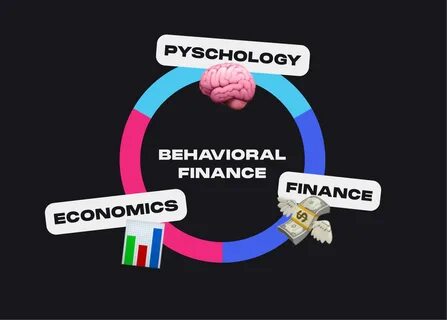
Outline:

I. Introduction
- Understanding Behavioral Finance and Its Impact on Investing
- The Role of Investor Psychology in Shaping Financial Decisions
- Why Managing Emotions Is Crucial for Long-Term Success
II. What Is Behavioral Finance?
- A. Definition and Overview
- B. Key Principles of Behavioral Finance
-
- Heuristics and Biases
-
- Overconfidence and Loss Aversion
-
- Herd Mentality and Anchoring
-
III. The Psychology of Investing
- A. Cognitive Biases in Investing
-
- Confirmation Bias
-
- Availability Bias
-
- Hindsight Bias
-
- B. Emotions and Their Effect on Investment Decisions
-
- Fear and Greed
-
- Regret and Overreaction
-
- FOMO (Fear of Missing Out)
-
IV. Common Behavioral Pitfalls in Investing
- A. Chasing Returns and Timing the Market
- B. Panic Selling During Market Volatility
- C. Overtrading and the Cost of Emotional Decisions
- D. Underestimating the Power of Long-Term Investment Strategies
V. How to Manage Emotions and Improve Decision-Making
- A. Developing a Rational Investment Strategy
-
- Setting Clear Investment Goals
-
- Creating a Diversified Portfolio
-
- Regular Rebalancing and Review
-
- B. Mindfulness and Emotional Regulation for Investors
- C. The Role of Financial Advisors in Managing Investor Psychology
VI. Smart Investing Strategies for Overcoming Biases
- A. Recognizing and Counteracting Cognitive Biases
-
- Understanding and Overcoming Overconfidence
-
- Avoiding Loss Aversion and Seeking Balanced Risk
-
- B. The Power of Dollar-Cost Averaging
- C. Using Behavioral Insights to Stay the Course During Market Fluctuations
VII. Building Wealth with a Long-Term Perspective
- A. The Importance of Patience and Discipline
- B. How Compounding Can Work in Your Favor
- C. Aligning Investment Strategies with Personal Values and Goals
VIII. Real-Life Examples of Behavioral Finance in Action
- A. Case Study 1: Panic Selling in a Market Downturn
- B. Case Study 2: FOMO and the Tech Stock Bubble
- C. Case Study 3: Overcoming Biases for Successful Long-Term Investing
IX. Behavioral Finance Tools and Resources
- A. Tools for Self-Assessment and Bias Recognition
- B. Psychological Insights in Investment Planning
- C. Using Technology to Improve Investment Decision-Making
X. Conclusion
- Summary of Key Points: Why Understanding Behavioral Finance Is Crucial
- Final Thoughts on Improving Investor Psychology for Long-Term Success
XI. FAQs
- What is behavioral finance and how does it affect investing?
- How can cognitive biases influence investment decisions?
- What are the most common emotional mistakes investors make?
- How can I avoid emotional decision-making in investing?
- What are the best strategies for long-term wealth growth?
READ MORE: Smart Investment Strategies for 2025: A High-Yield Guide to Diversified Portfolios, Risk Management.
Behavioral Finance and Smart Investing: Understanding Investor Psychology to Improve Your Strategy, Avoid Emotional Decisions, and Achieve Long-Term Financial Success

Investing is more than just a numbers game; it’s also about understanding human behavior and the psychology that shapes financial decisions. In a volatile market, emotions and cognitive biases can often lead investors to make irrational decisions that hurt their portfolios in the long run. Enter behavioral finance—a field that combines psychology and finance to explore how emotions, biases, and other non-rational factors influence investment decisions. This guide will help you understand how to recognize these psychological influences, avoid common emotional pitfalls, and develop a smart, long-term investment strategy that promotes consistent wealth growth.
Understanding Behavioral Finance and Its Impact on Investing
Behavioral finance aims to explain why investors often behave in ways that deviate from traditional economic theories, which assume that individuals act rationally and in their best financial interest. In reality, investor psychology plays a major role in shaping decisions, often leading to mistakes that undermine long-term success. By recognizing the psychological factors at play, investors can make better decisions and improve their financial outcomes.
The Role of Investor Psychology in Shaping Financial Decisions
At the heart of investing lies human behavior—investors are driven by emotions, biases, and past experiences, which can cause them to act impulsively. Understanding these psychological drivers is crucial for creating a well-balanced investment strategy that withstands market fluctuations and promotes long-term wealth growth. Whether it’s a fear of losses or the desire to capitalize on short-term market trends, investor psychology significantly influences the outcomes of their financial decisions.
What Is Behavioral Finance?
A. Definition and Overview
Behavioral finance is the study of how psychological factors affect investment decisions. It challenges the traditional notion that investors are always rational and always act in their best interests. In behavioral finance, biases, emotions, and social influences are seen as significant forces that shape the way people invest.
B. Key Principles of Behavioral Finance
1. Heuristics and Biases
Heuristics are mental shortcuts that help people make decisions quickly. While these shortcuts can be helpful, they often lead to biases in judgment. Common biases include:
- Confirmation bias: Seeking out information that confirms existing beliefs
- Anchoring bias: Relying too heavily on the first piece of information encountered
2. Overconfidence and Loss Aversion
- Overconfidence bias occurs when investors overestimate their knowledge or abilities, often leading to excessive risk-taking.
- Loss aversion is the tendency to fear losses more than valuing equivalent gains. This leads to conservative decisions, such as selling winning investments too early and holding onto losing investments too long.
3. Herd Mentality and Anchoring
- Herd mentality refers to the tendency of individuals to follow the crowd, particularly during market booms or crashes.
- Anchoring happens when investors latch onto specific numbers or information (e.g., stock price targets) and make decisions based on those anchors, even if they no longer reflect market realities.
The Psychology of Investing
A. Cognitive Biases in Investing
1. Confirmation Bias
Confirmation bias occurs when investors seek out information that supports their existing views or beliefs, disregarding information that challenges them. For example, if an investor believes a particular stock will perform well, they might only focus on positive news about that stock, ignoring negative reports.
2. Availability Bias
Availability bias occurs when investors make decisions based on readily available information, even if that information is not the most relevant or accurate. For instance, an investor might base their investment decisions on news headlines or recent trends that are easily accessible rather than conducting thorough research.
3. Hindsight Bias
Hindsight bias is the tendency to believe that an event was predictable after it has occurred. This can lead to overconfidence in future decision-making, as investors may believe they can easily predict the outcome of investments based on past events.
B. Emotions and Their Effect on Investment Decisions
1. Fear and Greed
Two of the most powerful emotions driving investors are fear and greed. Fear often leads to panic selling during market downturns, while greed can lead to risky decisions in the pursuit of quick profits. Both emotions can result in poor decision-making that negatively impacts long-term returns.
2. Regret and Overreaction
Regret can cause investors to overreact to past mistakes, often leading them to make decisions that are overly cautious or reactive. For example, if an investor loses money on a stock, they might avoid similar investments in the future, missing out on potential opportunities.
3. FOMO (Fear of Missing Out)
FOMO occurs when investors jump into a popular trend or stock because they fear missing out on potential gains. This emotional reaction can lead to poor timing, as investors may buy into overvalued assets during market highs, only to suffer losses when the bubble bursts.
Common Behavioral Pitfalls in Investing
A. Chasing Returns and Timing the Market
One of the biggest mistakes investors make is trying to time the market. Chasing short-term returns can be tempting, but it often leads to poor decisions based on emotions rather than sound investment principles. Market timing typically results in buying high and selling low, which is detrimental to long-term wealth growth.
B. Panic Selling During Market Volatility
Panic selling is a common behavioral pitfall during times of market volatility. Fear of loss causes investors to sell their investments at the worst possible time, often locking in losses. Instead of reacting emotionally, investors should focus on their long-term strategy and avoid knee-jerk reactions.
C. Overtrading and the Cost of Emotional Decisions
Overtrading—buying and selling frequently—can be a direct result of emotional decision-making. Not only does overtrading increase transaction costs, but it also exposes investors to greater risk. Staying focused on long-term goals rather than short-term market movements can help avoid overtrading.
D. Underestimating the Power of Long-Term Investment Strategies
Many investors neglect the power of compound interest and the benefits of holding investments for the long term. This can lead to missed opportunities for growth. Focusing on a disciplined, long-term investment strategy is one of the best ways to achieve financial success.
How to Manage Emotions and Improve Decision-Making
A. Developing a Rational Investment Strategy
1. Setting Clear Investment Goals
Establishing clear investment goals is essential to staying focused and avoiding emotional decisions. Whether your goal is retirement savings, purchasing a home, or funding education, having a clear purpose will help you stay on track during volatile times.
2. Creating a Diversified Portfolio
A diversified portfolio can help reduce risk and ensure steady long-term growth. By spreading investments across multiple asset classes (stocks, bonds, real estate, etc.), you protect your portfolio from the impact of market fluctuations.
3. Regular Rebalancing and Review
Regularly rebalancing your portfolio and reviewing your investments ensures that your strategy stays aligned with your goals. It also prevents you from becoming overly attached to individual stocks or sectors, reducing the temptation to act based on emotion.
B. Mindfulness and Emotional Regulation for Investors
Mindfulness practices can help investors stay calm and focused when making decisions. Techniques like meditation, deep breathing, and self-reflection can help reduce emotional stress, improve focus, and prevent impulsive actions driven by fear or greed.
C. The Role of Financial Advisors in Managing Investor Psychology
Financial advisors can play an important role in helping investors manage their emotions and make rational decisions. A trusted advisor can provide objective guidance, recommend appropriate investment strategies, and help investors stay disciplined in their approach.
Smart Investing Strategies for Overcoming Biases
A. Recognizing and Counteracting Cognitive Biases
1. Understanding and Overcoming Overconfidence
Overconfidence can lead to excessive risk-taking. By being aware of this bias, investors can counteract it by making data-driven decisions and not overestimating their ability to predict market movements.
2. Avoiding Loss Aversion and Seeking Balanced Risk
Loss aversion can prevent investors from making sound decisions. It’s important to balance the fear of loss with the potential for gain by maintaining a diversified portfolio and sticking to long-term investment goals.
B. The Power of Dollar-Cost Averaging
Dollar-cost averaging (DCA) involves investing a fixed amount of money at regular intervals, regardless of market conditions. This strategy helps reduce the impact of market volatility, and over time, it can lower the average cost per share, making it an effective strategy for long-term wealth growth.
C. Using Behavioral Insights to Stay the Course During Market Fluctuations
Behavioral insights can help investors stay focused during market fluctuations. By understanding the psychological factors at play, investors can make more rational decisions and avoid emotional responses to short-term market movements.
Building Wealth with a Long-Term Perspective
A. The Importance of Patience and Discipline
Building wealth through investing requires patience and discipline. By staying committed to your long-term strategy and avoiding emotional decisions, you can achieve financial success even in a volatile market.
B. How Compounding Can Work in Your Favor
Compounding is one of the most powerful forces in investing. Reinvesting dividends, interest, and capital gains can exponentially increase the value of your investments over time. By focusing on long-term growth, investors can harness the power of compounding to build wealth.
C. Aligning Investment Strategies with Personal Values and Goals
Aligning your investments with your personal values and financial goals ensures that your strategy remains focused and meaningful. Whether you are investing for retirement, education, or social impact, aligning your strategy with your values will help you stay committed during challenging times.
Real-Life Examples of Behavioral Finance in Action
A. Case Study 1: Panic Selling in a Market Downturn
An investor panics during a market crash, selling stocks at a loss and locking in negative returns. Had the investor stuck to their long-term strategy, they could have avoided making decisions based on fear and taken advantage of market recovery.
B. Case Study 2: FOMO and the Tech Stock Bubble
An investor succumbs to FOMO during the tech stock bubble, purchasing overpriced stocks based on hype. The investor suffers losses when the market corrects, highlighting the dangers of emotional decision-making.
C. Case Study 3: Overcoming Biases for Successful Long-Term Investing
An investor who recognizes their biases and focuses on a diversified, long-term investment strategy achieves steady growth despite market fluctuations. This case highlights the importance of overcoming cognitive biases to make informed, rational decisions.
READ MORE: Smart Investment Strategies For Beginners
Conclusion
Why Understanding Behavioral Finance Is Crucial for Smart Investing
Understanding behavioral finance is key to becoming a successful investor. By recognizing the psychological biases that influence decisions, managing emotions, and sticking to a well-thought-out strategy, investors can avoid costly mistakes and achieve long-term financial success. Whether you’re new to investing or an experienced investor, being mindful of your psychological tendencies can help you navigate the complexities of the market and make smarter, more rational decisions.
FAQs
- What is behavioral finance and how does it affect investing?
Behavioral finance examines how psychological factors impact financial decision-making, often leading to irrational behaviors that can affect investment outcomes. - How can cognitive biases influence investment decisions?
Cognitive biases like confirmation bias and loss aversion can lead to flawed decision-making, such as holding onto losing investments or overestimating the value of certain stocks. - What are the most common emotional mistakes investors make?
Fear, greed, overconfidence, and FOMO (fear of missing out) are common emotional mistakes that lead to poor investment decisions. - How can I avoid emotional decision-making in investing?
Developing a rational investment strategy, setting clear goals, and practicing mindfulness can help you stay focused and avoid making decisions based on emotions. - What are the best strategies for long-term wealth growth?
Dollar-cost averaging, diversification, and patience are key strategies for building long-term wealth while minimizing risk and avoiding emotional reactions to market fluctuations.






